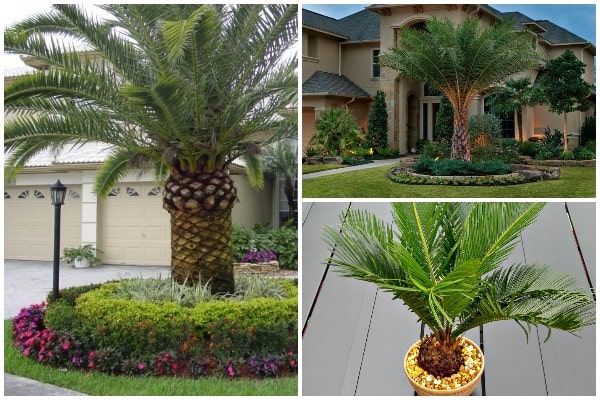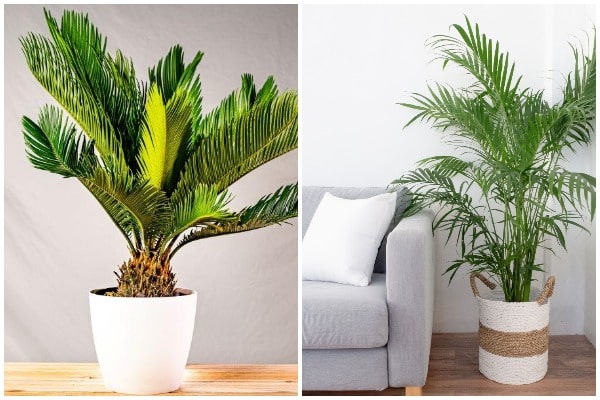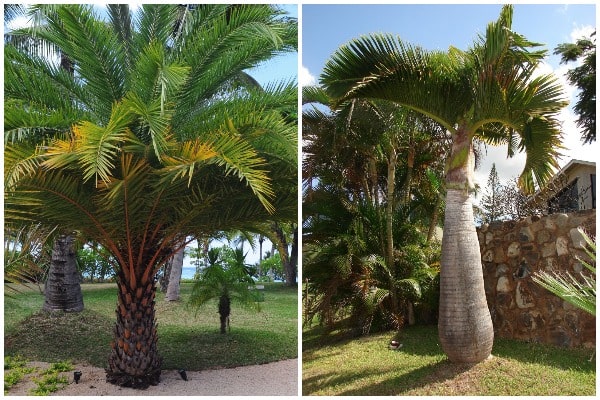There are thousands of different species of palm trees, which can make it challenging to choose the best option for your home. But selecting the best possible option is far easier when you’re familiar with them.
When choosing palm trees for home use, it’s crucial to consider whether they’ll be indoor or outdoor plants. It’s also vital to think about how much care your new palm tree will need.
Let us be your guide by introducing you to everything you need to know about these beneficial and aesthetically pleasing palms!

What Are the Best Palm Trees for Home?
There are quite a few different species of palm trees, but which could be the right choice for your home? The answer may depend on where you’d like to put those trees.
Some palm trees prefer the outdoor life, while others are more attuned to living indoors. Additionally, some species grow more easily in pots, but others prefer the unlimited soil space of a green yard.
Let’s take a look at some of the most common types of palm trees. We’ll also review the factors that make each species a good choice for their preferred environment.
This way, you can pick the best palm tree for home! After all, whether you live in a warm or cold environment, there’s a palm tree species that can work for your garden or home interior.
Also Read: How to Design a Garden That You’re Proud of
Outdoor Palm Plants
Outdoor palm plants can grow to astounding heights. When choosing an outdoor palm, the first thing you’ll need to consider is size. Some species can grow up to 100ft tall, which could be against your HOA’s rules.
And the larger the plant, the more soil and general maintenance it’ll require. That said, it’s easy to design palm tree borders and fences around your property using some of the larger species.
But if you’d rather decorate your outdoor areas with smaller species, you can always opt for one of the most common and beloved palms. Some of the best outdoor palms include:
- Chinese Fan Palm (Livistona chinensis)
- Queen Palm (Syagrus romanzoffiana)
- Mediterranean Fan Palm (Chamaerops humilis)
When planting outdoor palm trees, it’s essential to prepare the soil beforehand and measure your planting space. Of course, you could always opt for potted palms if you’d rather keep your trees mobile.
And if your outdoor space is limited, there’s no need to fear. Indoor palms are accessible, beautiful, and worthwhile.
Also Read: 10 Outdoor Landscaping Ideas to Overhaul Your Outdoor Space
Indoor Palm Trees

Now that we’ve discussed some of the best outdoor palm plants, we can touch on indoor options. Indoor potted palms could be an excellent alternative to outdoor options for several reasons.
Individuals with little yard space might choose an indoor palm due to space issues. Those who live in extremely hot or cold climates might also opt for an indoor palm.
Indoor palm trees can add a touch of class and elegance to any interior space. They’re also handy in helping to keep your home’s air clean and fresh.
Some of the best species for indoor potted palms include:
- Cascade Palm (Chamaedorea cataractarum)
- Sago Palm (Cycas revoluta)
- Areca Palm (Dypsis lutescens)
However, any moderate-sunlight species that grows to three feet or less in height could be a worthwhile option. Still, if you feel that you might want to choose a potted indoor variety due to cold weather, think again.
Several species do quite well in colder environments. You can find out more about cold-friendly palm trees if indoor potted palms aren’t your style.
Still, if you’re planning on keep potted palms, you’ll want to ensure that you’re providing proper care.
Also Read: Growing Indoor Plants as Part of Your Decor
Potted Palm Tree Care
If you’re leaning toward indoor options, you’ll need to consider potted palm tree care. And if you’re hoping to install a few potted palms outdoors, you’ll also need to do a little brushing up on your potted plant care techniques.
For example, potted palms often require larger containers than others types of plants. They also need just the right soil composition and plenty of light. Consequently, outdoor potted palms tend to be a little easier to maintain.
Some of the most crucial things to remember when caring for potted palms are:
- Soil pH (5.5 to 7.5)
- Sunlight
- Pests (Outdoor Plants Only)
- Container Size
If your potted palms begin to look a little sickly, you’ll want to check the soil pH first. You can do this by using a DIY home testing kit. If the pH is below 5.5 or above 7.5, you’ll need to add either lime or sulfur.
Palm trees are sunlight-loving plants, so you’ll also want to ensure that your potted trees are getting plenty of light. If you’re working with indoor plants, you can install specialized bulbs that mimic sunlight to keep them fit.
Alternatively, outdoor potted plants need the occasional wash and rinse. That’s because they can become infested with a wide variety of insects and pests. So taking a hose and washing your potted palms is crucial.
Lastly, there’s container size. Always double-check your preferred plant’s maximum growth size before choosing a container for it. Otherwise, your plant might end up growing sickly due to a lack of nutrients and soil space.
Things to Look For When Choosing Palm Trees

Whether you’re shopping online or at a local garden nursery, there are a few things you’ll want to keep an eye out for when choosing palm trees.
For example, in addition to choosing specific species, you might also want to consider the size of your chosen plants. Size is particularly crucial for those choosing indoor palms.
However, size isn’t the only factor you’ll want to think about. It’s also essential to consider:
- Plant Origin
- Zone Hardiness
- Maintenance and Care
- Price
- Maximum Growth
After all, some types of palms might be considered invasive in your area. Therefore, it’s also best to avoid those species whenever possible.
Additionally, if your preferred plants aren’t within your hardiness zone, trouble can ensue. Whether you’re shopping for indoor or outdoor plants, you’ll want to investigate how much maintenance and care your palms will need. For example, some palm trees require consistent pruning, fertilization, and soil amendment.
Finally, there are the issues of price and maximum growth. So naturally, it’s crucial to stay within your budget when purchasing new palm trees for home use.
Adding curb appeal may boost your home’s value, but it’s not worth going into debt over. Additionally, you’ll want to choose palm trees that have an acceptable maximum growth range.
You might purchase an easy-to-maintain 3ft palm that turns into a behemoth 10ft plant in the span of a few years. If you’re not prepared for that, you may end up removing the tree entirely.
Choose the Best Palm Trees for Home Today
Which are the best palm trees for home use? The answer depends on your climate and your preferences! Some species are better suited to colder or warmer climates and plants that prefer indoor living.
Choosing the right palm trees for your home means choosing ones that are either hardy enough to survive outdoors or acclimated to living inside. Whichever options you choose, you’re bound to enjoy the view.
Are you ready to upgrade your home’s decor? If so, be sure to check out our related home decor articles now!